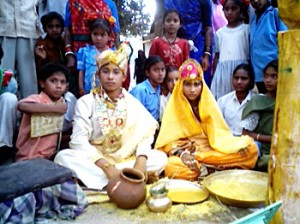Family Planning For Child Brides
 A little before lunch at the Global Summit for Family Planning, Maria Eitel, President and CEO of the Nike Foundation shocked the audience when she announced that every day 25,000 children were given away in marriage in Asia and Africa. Several of them became mothers before the age of 18, and 90% of childbirths among teenagers were the results of child marriage, not premarital sex.
A little before lunch at the Global Summit for Family Planning, Maria Eitel, President and CEO of the Nike Foundation shocked the audience when she announced that every day 25,000 children were given away in marriage in Asia and Africa. Several of them became mothers before the age of 18, and 90% of childbirths among teenagers were the results of child marriage, not premarital sex.
Ms. Eitel’s announcement was a bitter bite of reality for the entire audience; particularly for those who might have doubted the need to provide adolescents with contraception. It was also a much-needed wake-up call for several African and Asian countries, where policies on child marriage are divorced from policies on family planning.
This lack of coordination rings true in India. Child marriage falls under the domain of the Ministry for Women and Child development, while family planning programs are under the Ministry of Health and Family Welfare. Each department is restricted by its myopic goals: the former is bent on reducing the rates of child marriage, and the latter concentrates on preventing multiple pregnancies among older women. This lack of coordination and dialogue ignores the health of teenagers, who are still being forced into marriages in regions where the 2006 Prohibition of Child Marriage Act is only weakly enforced.
“Child marriage is a huge, huge, huge issue in India,” says Dr. Abhijit Das, the director of the Center for Health and Social Justice. For the last 20 years, Dr. Das has worked in the field of reproductive health and rights, and has advocated against this neglect of young girls. “It is a peculiar issue,” he said, “happening because of unrealistic bureaucratic vision, and the uncoordinated division of responsibilities. Each department is only concerned with whatever falls under its jurisdiction.”
This lack of dialogue renders Indian family planning services blind to the unmet needs of young girls. “Female sterilization happens to be the single most promoted method of family planning”, Dr. Das said, referring to the 50 lakh major surgeries that are done every year. “However, what young girls need is information about contraception and other services that are right for their age group.”
 The result of this bureaucratic ineptitude is startling. The failure to enforce laws against child marriage, force these young girls into relationships where they become easy targets for abuse. Several girls suffer from PTSD and chronic depression because of the years of sexual abuse (Read the ICRW facts on child marriage). To add this this, 50% of teenagers in India are anemic, 40% of Indian adolescents are out of school, 50% of Indian girls are married before the age of 18, and 15% of these girls are teenage mothers.
The result of this bureaucratic ineptitude is startling. The failure to enforce laws against child marriage, force these young girls into relationships where they become easy targets for abuse. Several girls suffer from PTSD and chronic depression because of the years of sexual abuse (Read the ICRW facts on child marriage). To add this this, 50% of teenagers in India are anemic, 40% of Indian adolescents are out of school, 50% of Indian girls are married before the age of 18, and 15% of these girls are teenage mothers.
This high fertility rate among teenagers adversely affects the economy of the nation. Though the growth of the population in the last decade was only 17.6%, the lowest it has been in 50 years, poverty is rampant. This is because there are more young women having children now, than there were 10 years ago. Dr. Das points out that this problem can be solved only if young girls are able to delay their pregnancies, complete their schooling, and empowered to provide for their families.
But current family planning schemes close the door on empowerment through their coercive two-child norm. In a presentation made in advance of the London Family Planning Summit, Dr. Das states that this coercive family planning policy disqualifies mothers of 3 or more from assuming positions of leadership in their community, and from applying for essential financial aid. The lives of these women remain steeped in poverty.
Social scientist Dr. Sushanta Banneerjee pointed out in a recent Ipas paper that unsafe abortion also remains a rampant issue in the Indian states of Bihar and Jharkhand because of misinformation, stigma and restrictive cultural norms. The rates are as high as 20% in some regions in spite of recent attempts by state governments and civil societies to improve access to safe abortion. The study urges the nation and civil societies to address this unmet need from the perspectives of these young Indian women, and make appropriate information available to them.
The Indian announcement at the London Family Planning Summit only glossed over these major issues. Though Ms. Anuradha Gupta from the Ministry of Health and Family Welfare promised that door-to-door contraception would become available through the next ten years, and culture appropriate counseling services would be provided to adolescents, there was no specific reference to married teenagers being forced to become mothers at a young age. This was disappointing especially when other nations like Malawi and Sierra Leone openly admitted that child marriage was indeed a major human rights issue in their countries.
Dr. Das thinks India will have to be shocked into facing reality. The current population policy began to focus on the maternal health only after India received stunning reports of Bangladesh’s progress. “It will take something equally shocking for us to admit child marriage is a problem. Maybe some country in Africa will solve it first.”
Whatever the wake-up call may be, it is not just India that is in need of it. Child marriage is rampant in other South Asian countries like Pakistan, Bangladesh, Sri lana and Nepal. In Bangladesh and Nepal, the issue is more severe: 60% of girls in Bangladesh, and 51% in Nepal become child brides. The issue extends to Taiwan and Thailand in the South East Asian region according to ICRW statistics. Several organizations are battling this issue, including the SAFE project in Bangladesh(Read more by clicking here), and the Girl Effect, launched by the Nike Foundation.
Dr. Das echoed the words spoken by Maria Eitel at the summit, when he explained that the solution to this global cultural problem lay in integrating child marriage policies with family planning policies. Both departments will have to work together to simultaneously stop the practice, and to delay teenage pregnancy. Until then the committments announced at the summit will remain a fantastic but unrealistic vision.






